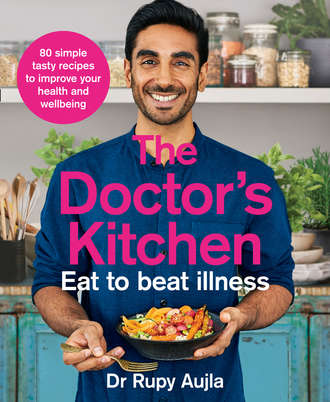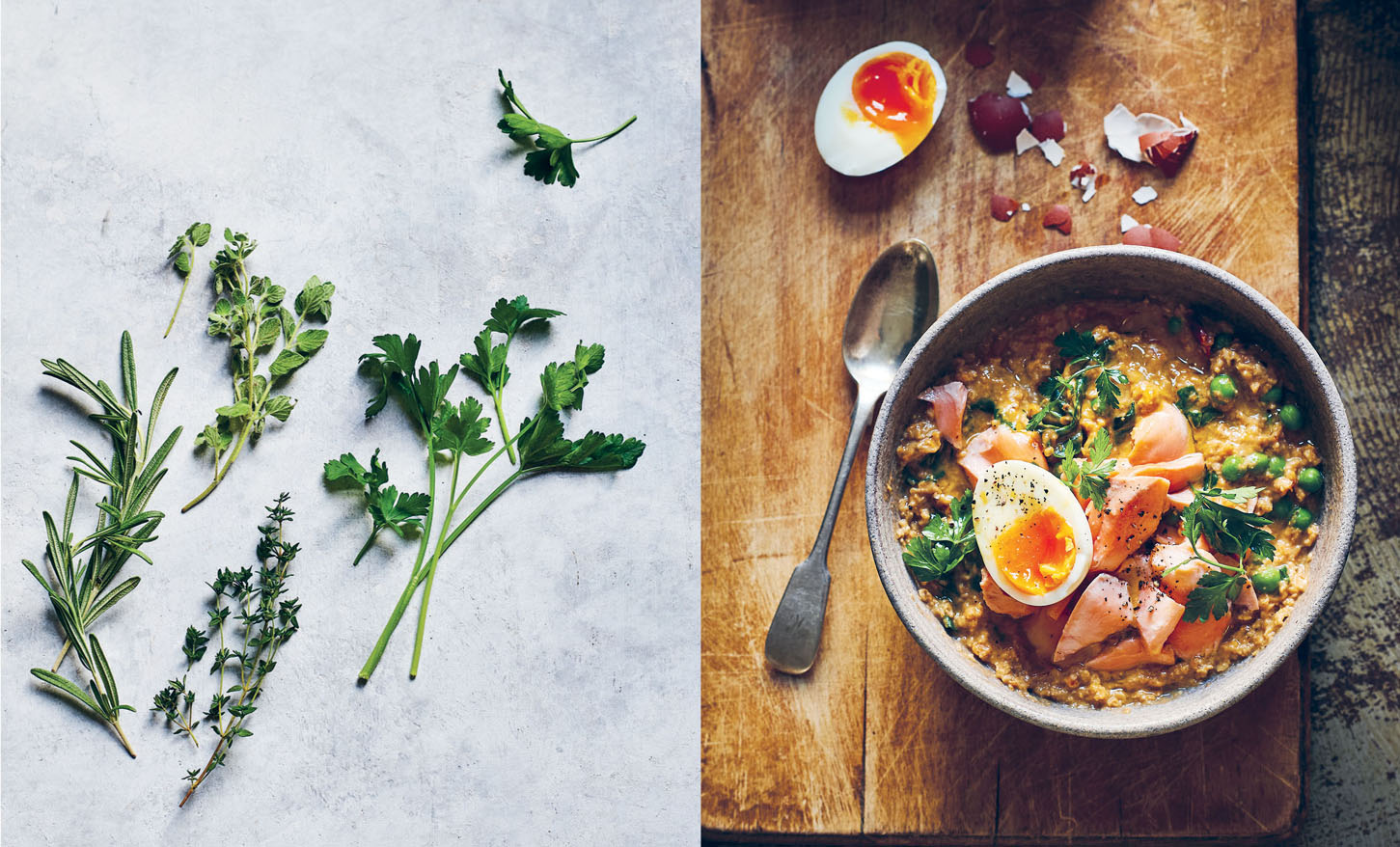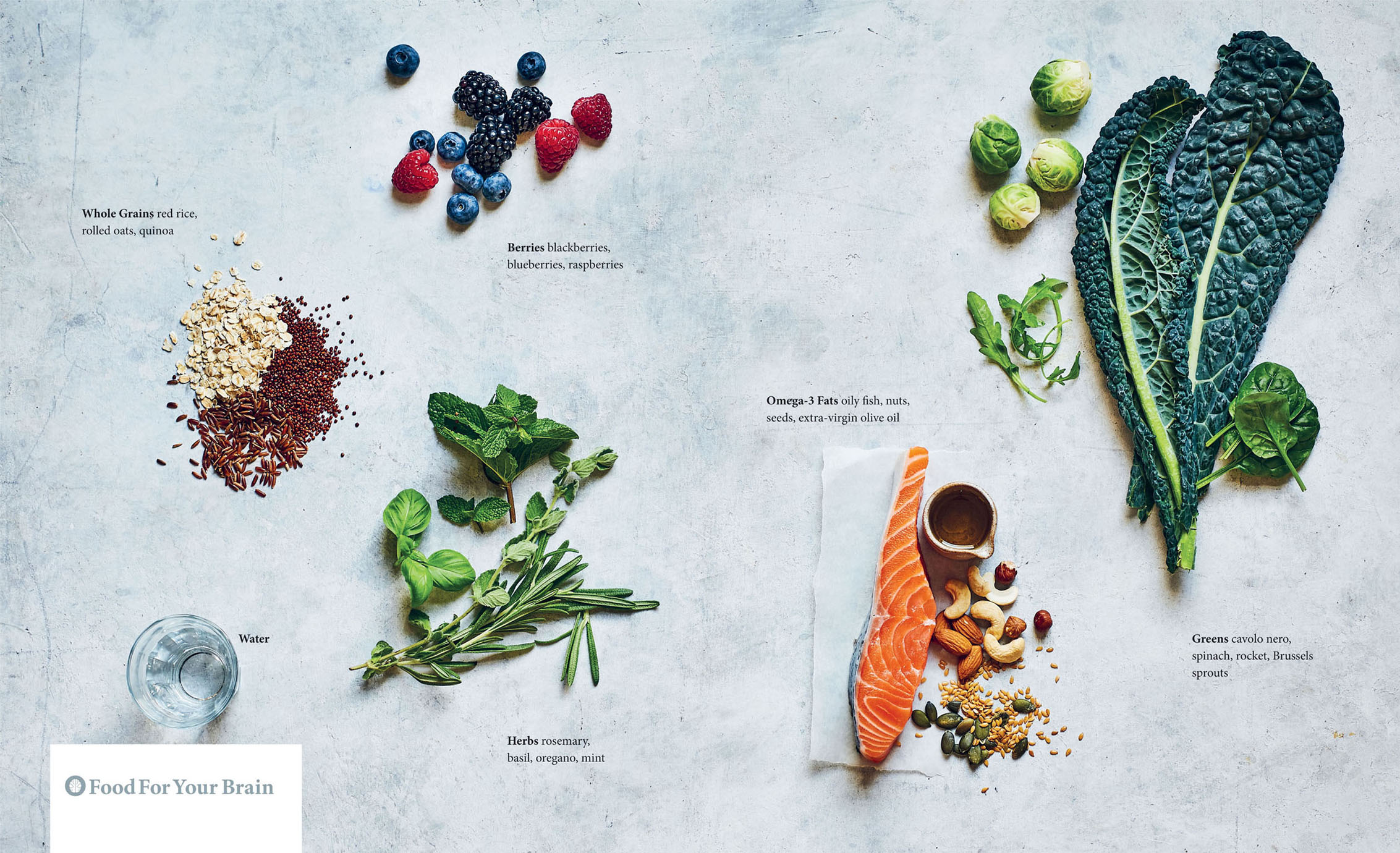
Полная версия
The Doctor’s Kitchen - Eat to Beat Illness: A simple way to cook and live the healthiest, happiest life

+ Berries These have received a lot of attention for being brain protective, with good reason. They are rich sources of polyphenols, including anti-inflammatory resveratrol and quercetin, but they may also be involved in the production of brain-derived neurotrophic factor (BDNF).23 BDNF is involved in the maintenance and survival of nerve cells and could be a critical component of protecting the brain against disease but also enhancing cognitive ability. I always have a mixture of berries in my freezer at home for convenience because they are as nutrient-dense as fresh and much less expensive.
+ Whole grains Examples of these, including red rice, rolled oats and quinoa, are great sources of antioxidants, fibre and B vitamins, which are essential for brain health.3 The brain is a sugar-dependent organ but excessive sugar that disrupts the normal mechanisms governing the control of glucose in the bloodstream has been shown to negatively impact brain cells.11, 24, 25
This is why whole grains with the fibre attached are so important from the perspective of sugar control. Rather than blindly counting carbohydrates and removing anything labelled a ‘carb’ I urge patients to consider the quality of ingredients. Barley, corn and millet are nutritionally very different to breads, pasta and cakes, yet they are all lumped together under the same banner of ‘carbohydrate’. Whole grains are what we should be eating as they release sugar into the blood gradually and have not had the important nutrients stripped away from them. My Sri Lankan-style Oats (see here) are a great way of using whole grains in an unusual dish.
+ Water Perhaps the easiest to access and the most commonly forgotten ingredient of all is simply water. All too often I ask patients about their drinking habits only to discover a shockingly low amount of hydration! Discounting certain medical conditions that would contradict 2 litres of plain water a day, and excluding tea and coffee (which can actually dehydrate us), this is how much we should be aiming for. It is essential for nutrient transfer across brain cells, delivering oxygen as well as maintaining the integrity of cell structures. The simple act of hydration has been demonstrated in clinical studies to improve cognitive performance and there’s no reason why we shouldn’t all be drinking adequate amounts.26 Drink for your mind.
+ Herbs and spices Most of these contain key antioxidants and phytochemicals (chemicals produced by plants) that can reduce oxidative stress.27 As a general rule of thumb, using simple kitchen herbs like rosemary, basil, oregano and mint in your cooking is a great way to reduce inflammation and improve the enjoyment of food. Certain chemicals labelled ‘adaptogens’ or nutraceuticals, including ashwaganda, curcumin and gingko (to name just a few), have been given a lot of attention in the press over recent years, claiming to boost brain health with regular consumption. While I welcome greater research into compounds that are safe and well tolerated, the biggest impact on brain health is not going to come from a nutraceutical pill. I wouldn’t like anyone to believe that simply taking supplements in isolation is the best way to protect your brain. It’s going to be your plate and lifestyle that has the biggest impact.
LIFESTYLE 360
I could talk extensively about micronutrients, including vitamins E and D, or the power of individual phytochemicals, but this would neglect the importance of ‘food synergy’. We don’t eat nutrients in isolation and I’m a firm believer of an integrated dietary approach. By overanalysing single elements of our diet we miss the wider picture about the combinations of food we consume and how difficult it is to tease out what’s having an impact. We need to experiment with new and delicious ingredients but in addition, the synergistic effect of lifestyle alongside diet is a powerful combination to be reckoned with.
+ Mental training and stimulation These have been observed to increase a type of material in the brain called ‘grey’ matter that makes up parts of the brain involved in emotion, coordination and perception.28 You don’t have to just do Sudoku or mathematical exercises – meditation and mindfulness regimens have also been shown to demonstrate increases in grey matter.29 Playing a musical instrument, singing or any activity that focuses attention may lead to benefits and are worth the time investment to keep your brain healthy.
+ Chronic stress It has been shown that a high level of stress induces structural changes in the brain, which suggests our emotions are potent modulators of our brain’s anatomy.30, 31 In clinic, I emphasise the need for simple stress-relieving strategies, such as yoga, deep breathing and meditation, that heighten neural activity in the brain’s pleasure centres and improve our tolerance to stress.32 These powerful tools are accessible to everybody and, if taught appropriately, research shows can be very effective.
+ Exercise High intensity interval training (HIIT) and endurance exercises reduce the incidence of cardiovascular disease, which would ultimately reduce the likelihood of cognitive decline. But exercise itself also induces the production of ‘neurotrophic’ factors that enhance nerve cell generation and protect against shrinkage of the brain that occurs as we age.33 Our bodies are designed to move constantly, but I find that many patients are confined to their desks in their working environments. Whether it’s a case of getting a standing desk or taking the stairs, I advise to try to move as much as possible throughout the day – exercise is not confined to the gym. Your brain will thank you for it.
+ Sleep Sleeping to both protect and greatly enhance brain function is the lowest hanging fruit, yet few of us practise good sleep hygiene. The constant stimulation from TV platforms and mobile electronic devices creates an environment associated with disrupted sleep. During sleep your brain’s lymphatic system (the system that removes toxins and waste products as a result of normal cellular processes) gets to work to clear debris that can impact the functioning of your nerve cells.34 There is a clear link between poor sleep and a higher likelihood of cognitive decline, and on the other side of the spectrum, boosted cognitive performance when you are well rested. Getting a good quality 8–9 hours of rest per 24 hours is one of the simplest ways to boost brain health. Make yourself a promise: try it for 7 days and monitor how you feel. It will revolutionise what you prioritise.
By employing all these tactics we can positively impact our brain on multiple levels. We have the power with our diet to reduce inflammation, stimulate brain growth factors, promote neuronal cell production, reduce oxidative stress and improve many other processes that we have yet to discover. As well as all these dietary and lifestyle changes being protective, the aforementioned activities are also being considered in management to improve outcomes or prevent further decline in patients to good effect. This is where we need to invest more of our time and resources, but I’m making this vital information accessible to you right here. Don’t wait for the prescription pad. Take advantage of these points and start looking after your brain health right now. As you’ll discover in all the other chapters in this introduction, eating and living well doesn’t solely effect your brain health, but rather your entire ecosystem.


Heart

If you’re tempted to skip over this chapter because you’re in your mid-twenties or early thirties and you believe heart disease is only something of concern in later life, think carefully about flicking past these pages. Heart disease isn’t something that suddenly becomes relevant as soon as we reach a certain age threshold. We build the foundations for a healthy or unhealthy heart in our childhood and we are starting to see the early signs of atherosclerosis (narrowed, inflamed arteries) in those as young as teenagers.35 But rather than scaring you into booking a CT angiogram to determine the state of your vital organ, I want to show you how much control you have using your fork.
Our heart is a complex machine that generates electrical energy to synchronously contract its muscles, pumping blood around our network of vessels. The blood contains vital oxygen molecules, as well as nutrients to feed every cell in our body, but the heart itself is desperately reliant on the same nutritional need. Micronutrients like potassium, magnesium and calcium are essential to ensure the contractility of this muscular organ that, hopefully, will never stop throughout our entire existence.
If you hit the gym harder than usual and you’re dehydrated, or perhaps you haven’t had adequate nutrition prior to your workout, your muscles will feel stiff and generally fatigued. Feed yourself the right fuel, however, and you’re less likely to feel the negative effects of training. Our heart muscles are categorically different from the skeletal muscles in our limbs, but the general principles of feeding our muscle tissue still apply. It’s vital to ensure your heart is adequately nourished to perform its function throughout its lifetime and make lifestyle choices that nurture this beautiful, industrious machine. Thankfully, this isn’t hard, and the food you can enjoy is still incredibly delicious and exciting.
It’s important to remember that the heart (like most organs) is incredibly resilient. As demonstrated by some impressive studies, reversal of atherosclerosis can be achieved with a lifestyle that encourages your body to look after itself.36 A number of cardiologists have demonstrated, using both blood tests and imaging to look at the vasculature of the heart, that a healthy lifestyle can reduce blockages of the arteries.37, 38 This is absolutely groundbreaking and something not thought possible up until a few years ago. In fact, some lifestyle medicine programmes have become so effective at reversing cardiovascular disease that they’re now covered by American health insurers.39, 40
But rather than trying to just reverse heart disease, I want to focus on the habits that will prevent the life-changing event of a heart attack that happens to over 100,000 UK citizens each year. Yes, there is evidence to suggest that we can drastically improve post-heart attack symptoms with intense lifestyle changes, but the better and more effective aspiration is to prevent that stage in the first place.
THE MEDITERRANEAN WAY
The Mediterranean diet has been heralded as the most heart-healthy diet and evidence supports this. When we look at large population studies, it’s clear that a Mediterranean way of eating, that includes plenty of fruits, vegetables, good-quality oils and healthy fats, significantly reduces the likelihood of high blood pressure, strokes and heart disease.41, 42 A representative dish of how to eat with this focus in mind is my Roast Walnut and Squash Medley with Persillade (see here) or the Aubergine and Walnut Ragu (see here).
We can analyse why this may be the case by examining the components of a Mediterranean way of eating. The focus is on colourful vegetables such as tomatoes, squash, lentils and dark leafy greens, which are fantastic sources of the micronutrients necessary for optimum cardiac muscle function.43, 44 The most extensively studied of these micronutrients include potassium, calcium, magnesium and co-enzyme Q10,45 but there are a huge number of other plant chemicals found in the same foods that we still haven’t fully investigated the effects of.46
There are now over 30 years of data, including the results of the Lyon Heart Study, PREDIMED studies and other large research projects that all point towards Mediterranean-style diets and lifestyle modifications as being significantly more effective at prevention of cardiovascular disease than drugs combined.41 To put this another way, if you change your lifestyle and eating habits, it has a more powerful effect on your health than any number of medication combinations I can prescribe. This is simply not common knowledge among our population, nor medical professionals and, quite frankly, it should be printed on the front door of every cardiac unit and general practice surgery in the country. Considering the exorbitant cost of medications and interventions directed at preventing cardiovascular events that our healthcare system invests in,47 there is simply no excuse for why diet education should not play a central role in healthcare. We do ourselves a disservice by not engaging in this conversation and it is where we need to direct our resources.
NUTRIGENETICS
If you happen to have a family history of heart disease, you may be thinking to yourself that your genes are your destiny and there isn’t much you can do about your ‘dirty DNA’. On the contrary: studies have shown that we are more in control of our heart disease risk than previously thought. Our genetic blueprint is inherited from our parents; this information is stored in every cell of your body and it is unchangeable. However, we can change the OUPUT of our genes by changing what we put IN to our system.48 The ability to change the expression of our genes is a concept I introduced in my first book. Nutrigenetics, nutrigenomics and epigenetics are among a few novel science disciplines that focus their attention on the role of nutrients and bioactive food compounds in gene expression.49 When I personally learnt more about this field, it revolutionised my perspective on just how important food and our lifestyle is.
Once we begin to understand and believe in the power of environmental influences on the very foundations of our existence, it becomes clear why diet is one of the most technologically advanced treatments we have in our armoury against disease. When you consume food it ‘speaks’ to your DNA and this communication can either lead to an overall positive or negative outcome. By introducing colourful foods, nutrient-dense ingredients and good-quality fats (which all the recipes in this book contain) we not only provide micronutrients and proteins for heart function, but we are also changing the messages transmitted via our DNA.50 Cardiologists are now warming to the idea that nutrigenomics has a role in their speciality and I see more specialists attending lectures in nutrition, engaging with me on social media and at talks, wanting to learn more. This area of research gives us further mechanistic information about why particular diets like the Mediterranean diet are so cardio protective50 and I’m sure biomedical informatics will help tackle the complexity of this field.
What we can be certain of is that the root cause of – and solution to – the clear majority of cardiovascular diseases that I see in the emergency department and primary care is manageable with lifestyle. This fact alone should give us a clue as to where we should be concentrating our attention and resources.
STOP THE STRESS
Beyond the nutrients necessary for contracting the muscular walls of our heart, this organ is vulnerable to ‘oxidative stress’, a topic we discuss in the chapter exploring inflammation (here). High levels of inflammation have been shown in many animal and human models to be detrimental to the walls of arteries.51 Oxidative stress can be created by high blood pressure, smoking, as well as high-sugar diets that can lead to the creation of ‘advanced glycaemic end products’ (AGEs). These products concentrate in parts of the heart vessels creating inflammation that can lead to plaque formation.52 By ensuring your lifestyle reduces inflammation, limits foods high in sugar and refined carbohydrates (like white rice, bread, pasta, cookies and cakes) you can prevent unnecessary oxidative stress and fuel your body’s natural inflammation-balancing mechanisms.

A Mediterranean-style diet has been shown to reduce oxidative stress, lower blood pressure and improve the health of blood vessels.41 In addition, a diet high in green vegetables such as broccoli, parsley and sprouts not only contains oxidant scavengers like vitamin C and heart-stabilising minerals like magnesium,53 but phytochemicals including sulfurophane, indole-3-carbinol and quercetin that are known to be potent anti-inflammatory ingredients.54
‘Whole sources of fat such as pecans, walnuts, sunflower seeds and minimally-processed extra-virgin olive oil are fantastic additions to your diet from a heart-health perspective.’
BALANCED FATS
Despite years of being told fat should be stripped out of our diets, sources of good-quality fat such as nuts, seeds and extra-virgin olive oil feature heavily in Mediterranean diets which are heart healthy. The detrimental low-fat message needs to be addressed. It’s been heavily over-simplified and it’s a confusing topic for many patients who still believe all sources of fat are harmful. To put it simply, whole sources of fat such as pecans, walnuts, sunflower seeds and minimally-processed extra-virgin olive oil are fantastic additions to your diet from a heart-health perspective. Not only do they contain key minerals like selenium and magnesium but they provide antioxidants such as vitamin E, which can protect the heart from oxidative stress.55 Algae oil and wild oily fish also contain long-chain Omega-3 fatty acids that have been shown to be anti-inflammatory56 and vital additions to a heart-healthy diet.
Two types of fatty acids, Omega-3 and Omega-6, have been given a lot more attention in studies trying to explain the rise of heart disease in western countries. Omega-6 is found in cereals, wheat and animal products but also within vegetable oils, nuts and seeds. Omega-6 is generally thought to be pro-inflammatory but, as we will learn in the inflammation chapter (here), the process of inflammation is essential for our body and this is why we need some sources of Omega-6 in our diet. The issue appears to arise where the ratio of Omega-6 to Omega-3 in our body falls out of balance. Throughout our evolution we would have had equal amounts of 3 and 6 or a ratio between 1:1 to 1:4.57 However, western diets high in poor-quality industrial corn and soy oils, refined cereals, wheat and animal products tip the balance to one that has a much higher ratio of Omega-6 than is sensible for human health.
The mechanism by which different fats impact our health is more complicated than simply turning inflammation on and off. Fatty acids modify the blood’s ability to clot and even influence gene expression of cells in our vessels.58 To put it simply, it’s all about ratio, but rather than suggesting we all diligently calculate our Omega-3 to Omega-6 percentages, my advice would be to concentrate your fat sources on whole foods such as nuts and seeds. Use minimally processed oils like extra-virgin olive oil and limit your intake of biscuits, fried foods and refined snacks like crisps. Follow these principles and your ratios are likely to be optimal for general as well as heart health without having to obsess about the numbers.
Our plates are a gateway to using the thousands of compounds that assist our body’s inherent ability to look after itself. Recipes such as my Aubergine and Walnut Ragu (see here) or the Jambalaya (see here) are great examples of the types of food we need to concentrate our diet around. These include vegetables, fruits, spices and specific fats that help reduce our risk of heart disease through a multitude of cellular processes. Here are some of the foods I regularly recommend in clinic to patients interested in heart-healthy meals:
+ A rainbow of colours There is a significant body of clinical data and large studies to demonstrate that antioxidant-rich diets reduce blood pressure and cardiovascular risk59 and, as a general rule of thumb, colours mean antioxidants. Look for a rainbow of colours in your diet and you’re likely to be including a plethora of micronutrients that will positively impact your heart. Of particular note, I like to include red and purple foods such as berries, beetroot, red cabbage and grapes. These contain phytochemicals such as the betalains and anthocyanins that have been shown to relax blood vessels and lower high blood pressure.60, 61, 62
+ Calcium and potassium These minerals are essential for vascular health. You’ll find calcium in ingredients such as chickpeas, puy lentils and sesame seeds, and both potassium and magnesium are abundant in dark greens such as cavolo nero, spring greens and Swiss chard. The heart is an energy-generating organ that relies on these minerals to appropriately conduct electricity through its tissue fibres. By eating these types of foods, you ensure the availability of these essential nutrients to safeguard optimal heart function.
+ Fibre As well as the minerals contained within beans, legumes and pulses, these foods offer a variety of fibre sources. As with most aspects of health, your gut microbes have a significant role in cardiovascular disease and there is a clear ‘gut-heart’ connection.63 Inflammation is an important contributor to the mechanism of cardiovascular disease and nurturing a robust gut population with plenty of fibre sources reduces inflammation and can prevent damage to arteries that can cause heart attacks and strokes. In addition to pulses and legumes, chicory, garlic, onion and leeks are fantastic fibre sources that will encourage a healthy microbiota.
+ Good-quality fats These have been shown to have positive effects on the expression of your genes, which create a more favourable cholesterol profile and improve fat distribution around your body.49 The fats to focus on are those from whole plant sources: concentrate on the least refined types. These include walnuts, pistachios, almonds, oily fish, cold-pressed virgin oils (like avocado, rapeseed and olive) and seeds. These tend to have higher amounts of unsaturated versus saturated fats, but I’d rather you pay attention to foods rather than the biochemical profiles of ingredients. I’ve found in clinical practice that it’s a waste of mental energy to try and entertain the different arguments for and against certain fats. The reality is, all fats contain both unsaturated and saturated categories in varying proportions and subtypes. It doesn’t make any sense to suggest we should remove all saturated fats from your diet when every fat you can think of will contain some amount of saturated fat. Trust me on this one: your heart will thank you for focusing on plentiful whole, largely plant-based fats and enjoying fats from animal products like meat and dairy on occasion.
LIFESTYLE 360
Diet is just one of the many strategies to positively impact metabolism, genetic expression, body-fat distribution and many more processes that benefit your heart.64 Now consider the extra medicinal benefit of complementing delicious food with lifestyle modifications. As a starting point, the recommendations of smoking cessation, alcohol moderation and exercise are essential, but this is not where lifestyle advice stops. Over and above these well-known factors are other extensively studied recommendations that I’ve outlined below.
+ Sleep If there was one thing I could change about my patients’ habits, from the perspective of improving heart function, it would be to get more sleep. Sleep deprivation is correlated with higher blood pressure, higher measures of inflammation and worsening cholesterol profiles, all of which contribute to heart disease.65 Findings from multiple studies demonstrate that a lack of sleep causes raised stress hormone levels and activation of your ‘fight or flight’ system which leads to changes in your mental ability as well as causing strain on your heart. In addition to the direct impact, after a poor night’s kip your brain sends signals to make you hungrier, making you more likely to crave that sugary croissant or salty fried snack, which will compound the detrimental impact.66 As with most things in medicine it’s not about quantity but quality. Seven to nine hours a night is a general rule of thumb, but try measuring how long you sleep at the weekend without an alarm waking you the next day and being aware of how refreshed you feel. This will give you a personal indication of generally how much sleep you should be aiming for during the working week, too.


